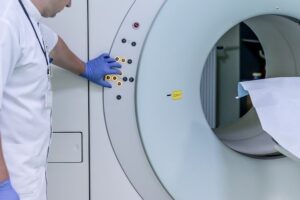How is Neck or Back Pain Diagnosed?
If you read articles on the Saratoga Spine blog, you’ll notice we often discuss different conditions that cause neck or back pain and how they’re treated. However, how do the doctors know which treatment is best? Or which condition each patient has? In other words, how is neck or back pain diagnosed?
Office Visit Exams
During your office visit the doctor may observe your stand or gait. They may also ask you to bend to the left, or right. These range of motion and other visual tests can give the doctor information to help with their diagnosis, and treatment plan.
Imaging Exams
X-Ray
Probably the most well known imaging exam, an x-ray uses radiation transmission through a body to create an image.
CAT Scan / CT Scan
Computed axial tomography (CAT) scans and computed tomography (CT) scans is another method a doctor can use to help diagnose back pain. CAT or CT scans utilize x-rays and a computer to develop a three-dimensional model of a specific area of the body. These types of scans are helpful in showing fine detail of bone to follow progress after a surgical procedure, or, identify a fracture in a patient who cannot have an MRI.
MRI
 MRI is the abbreviation for a test known as magnetic resonance imaging. It is another type of imaging exam in which radio waves are applied to a portion of the body causing the atoms to resonate. This nuclear magnetic resonance is then used to create a detailed computerized image of inside the body. Patients with defibrillators, pacemakers, and some others are not able to undergo an MRI exam.
MRI is the abbreviation for a test known as magnetic resonance imaging. It is another type of imaging exam in which radio waves are applied to a portion of the body causing the atoms to resonate. This nuclear magnetic resonance is then used to create a detailed computerized image of inside the body. Patients with defibrillators, pacemakers, and some others are not able to undergo an MRI exam.
Doctors have many tools available to them to help with diagnosing back pain. Using a combination of tests doctors can identify the source of the pain and determine an appropriate method for treating it.
EMG
An electromyogram (EMG) is a test which measures your muscle response to nerve signals. Results from an EMG can help differentiate between a muscular or neurological issue. An EMG is helpful in identifying pinched nerves that can be caused by a herniated disc, for example.
